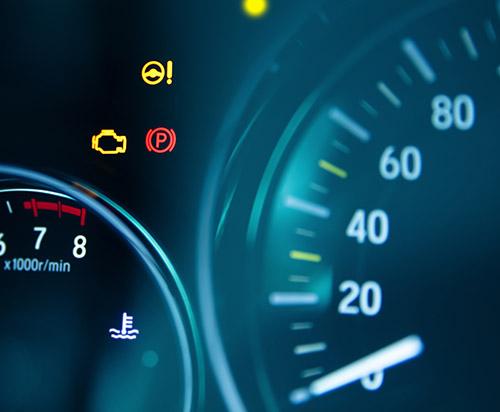How it Works
I push on my brake pedal, and the car stops. It’s magic! No. The truth is, the brake system is far from magic. In order for the brakes to bring your vehicle to a stop, various parts and fluids within your brake system must be in good working order. Dirty fluid, worn pads, failing circuits, sensors, cylinders, etc., can all cause your brake system to fail.
The brake system in most modern vehicles is a hydraulic system made with either disc brakes, drum brakes, or a combination of the two. The hydraulic brake circuit has fluid-filled cylinders connected by pipes, otherwise referred to as brake lines. When you push the brake pedal a piston is depressed which forces brake fluid from the master cylinder to slave cylinders, forcing pistons to apply pressure to the brake pads or shoes, which slows the vehicle. Most vehicles have an anti-locking system that keeps the rear brakes from locking up if too much pressure is applied during heavy braking. Some cars also have power-assisted brakes reducing the effort needed to apply brakes. All cars have a hand brake system as well, which is called the parking brake.
All brake systems are comprised of wearable parts and require maintenance. Neglecting your brakes is dangerous to both you and others on the road. If you require brake repairs in Mesa, AZ, give New Dimensions Automotive a call at (480) 218-0096. Our certified brake technicians can get you back on the road safely in no time.
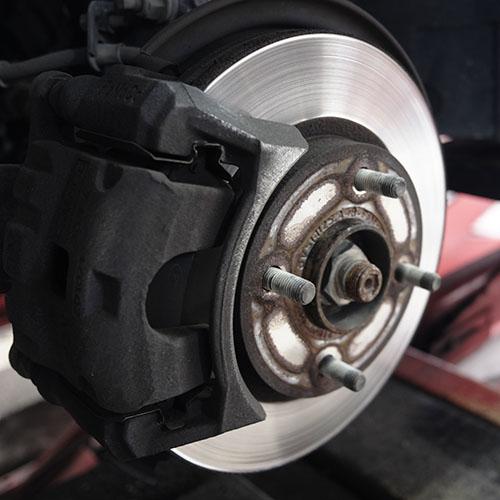 Maintenance
Maintenance
How long your brakes last is dependent on many factors including your vehicle’s design and your driving habits. If your daily commute includes lots of stop-and-go, your brakes are being used more frequently and the pads or shoes will wear more quickly. If you drive quickly and perform hard stops, this too can wear the brake pads and potentially warp rotors due to overheating. “Riding” the brakes also wears the pads and warps rotors due to excessive heat. It’s always better to apply moderate pressure and release, giving your brake system a chance to cool. If you haul a trailer, boat, or other toys, the extra weight and additional braking can put wear on the system. Steep grades (up and downhill braking), as well as weather conditions like snow, ice, or rain all play a role in how long your brakes will last.
It’s always a good idea to have your brake pads inspected every 6-months, or sooner if you suspect a problem. Things to watch for are squeaking or grinding sounds, slower braking power, shaking or pulsating, or smells of burnt metal. Often a squeaking sound can be corrected by cleaning the brakes with a good brake cleaner, which also helps your brakes perform better. It’s always best to have your brake system inspected by a professional. The technicians at New Dimensions Automotive can help with brake inspections and repairs all backed by a Nationwide Limited Warranty.
Diagnostics
New Dimensions Automotive performs brake diagnostics to pinpoint what component within the braking system requires attention. Whether it be trouble with your brake lights, brake squeals, vibrations, or a dashboard indicator, your car could be unsafe to drive. Contact New Dimensions Automotive at (480) 218-0096 to schedule a brake diagnostics today.
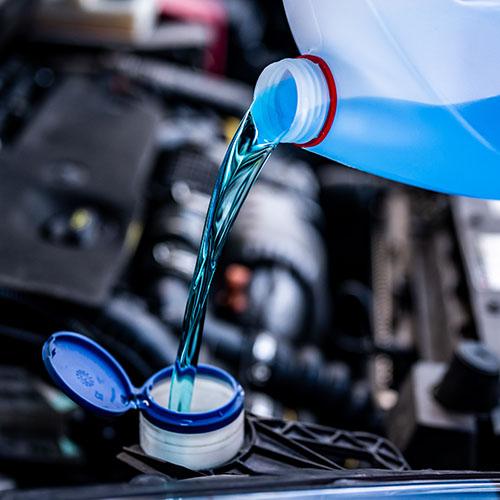
Brake Fluid
Brake fluid is a hydraulic fluid required to make your vehicle stop. When you press on the brake pedal, fluid travels through brake lines to the calipers or drums to stop your vehicle. Because of the important role brake fluid plays in the braking system, the United States regulates the fluid performance requiring it passes a series of tests established by the Department of Transportation National Highway Traffic Safety Administration. Brake fluids are referred to by their DOT (Department Of Transportation) number. The most common fluid used in today’s vehicles is DOT3 or DOT4, which are amber in color.
Brake Lines
Brake lines are the tubes that carry brake fluid from the master cylinder to the brakes. Brake lines come in a variety of materials including steel, rubber, or copper-nickel. Brake lines can develop a leak, which oftentimes can be hard to detect due to the clear-ish color of brake fluid. Rubber brake lines can crack or become moist or soft. Metal brake lines can corrode or rust. If the brake light in your vehicle has been illuminated, you may have a fluid leak from your brake lines. Have the technicians at New Dimensions Automotive do a brake inspection to ensure your brake system is safely operating.
There is no universal schedule dictating when you should change your brake fluid, it varies on your vehicle’s manufacturer, how you drive, and environmental conditions. In general, your fluid should be inspected by a mechanic at each oil change, and you should expect to change the fluid at least every four to five years. If you require a brake flush call New Dimensions at (480) 218-0096. Our certified technicians use a pressure bleed system to professionally replace dirty fluid and air with new brake fluid.
 Brake Rotors (discs)
Brake Rotors (discs)
Brake rotors, also known as discs, are what the brake pads clamp down to when you press your brake pedal, stopping the wheel from turning. Some brake rotors are drilled or slotted, which allows heat, gas, and water to escape keeping the rotor surface clean. Drilled rotors can weaken over time, even cracking under stressful driving conditions. Slotted rotors are more durable but can wear brake pads more quickly. In today’s vehicles, manufacturers commonly make thinner rotors from recycled, lighter materials, rather than the heavy thick steel used in the past. This has decreased the overall vehicle weight, improving fuel economy, but also means the rotors are prone to corrosion and wear more quickly. It is not uncommon to replace rotors each time you replace brake pads. “Turning” rotors is not typically an option, because the rotors are too thin to machine down. If you hear squealing, squeaking, or even worse- grinding sounds, it’s time to have your brakes checked by New Dimensions Automotive. Our technicians can repair brake rotors and pads, getting you back on the road quickly and safely.
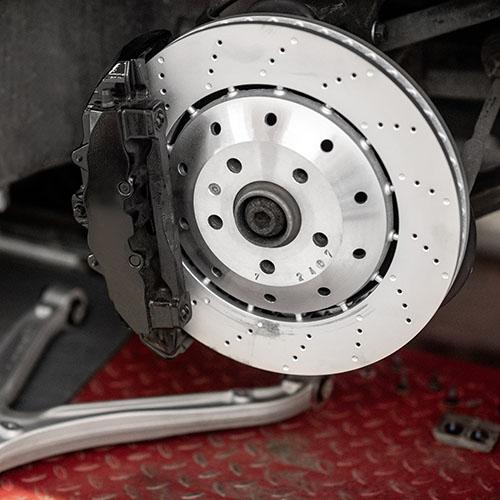
Brake Calipers
Brake calipers for disc brakes are like clamps for the rotors. Some signs of a bad brake caliper are: leaking fluid which can smell of burnt rubber, reduced braking power, high pitch noises or loud thuds when applying the brakes, the constant feel that brakes are engaged, or your vehicle pulling to the left or right. All of these can be signs of failed calipers. New Dimensions Automotive can do a brake inspection of your system to make sure your calipers are in working order.
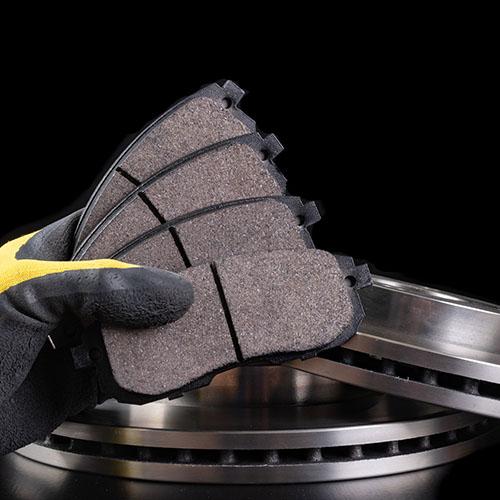
Brake Pads
Brake pads are the most commonly known parts of the brake system. Brake pads are responsible for rubbing against the brake rotor, which creates pressure and friction to stop the wheel from spinning. Brake pads are made from materials such as alloys, ceramics, and carbon-based composites, all of which won’t melt under extreme heat. All brake pads will wear over time and require replacement. How often pads need replacing really depends on your vehicle, the pad materials, and your driving habits. Many brake pads have a wear indicator that will rub against the rotor once the pad has been worn past a certain point, which will create a squeaking or screeching sound. It’s never a good idea to ignore these sounds, additional wear to the pad can damage the rotor, increasing the cost of the repair significantly. Another way to check whether brake pads need to be replaced is by looking at the thickness of the pad, which should be 1/4″ or greater. Some pads have a wear indicator slot down the middle. If the slot is barely visible or gone, it’s time for new pads. Less brake dust on your tires can also be a sign the pads have worn down to the metal backing. The technicians at New Dimensions Automotive have gauges to measure pad thickness and give you an estimate as to the life left in the pad. If you need new brake pads, New Dimensions Automotive offers many options and can help fix your brakes without “braking” the bank.
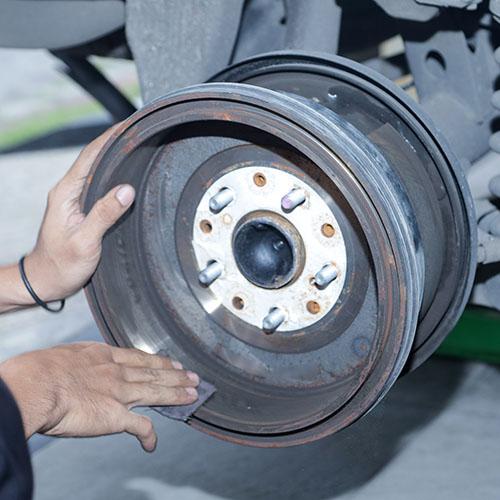 Brake Drums
Brake Drums
A brake drum is a type of brake system where the slave cylinder pushes shoes into the drum which is attached to the wheel to stop the vehicle. Some signs that you may have a bad brake drum are an unusual feeling when you press the brake pedal, an abnormal or loud scraping noise when you brake, or even a loose parking brake. New Dimensions Automotive offers both drum brake diagnostics and drum brake repairs in Mesa, AZ.
Brake Shoes
Brake shoes are part of a brake drum system. A brake shoe is designed to fit in the brake drum, and when the brake pedal is engaged will apply strong friction to the spinning drum stopping the vehicle from moving. Brake shoes are made of hard-wearing materials and provide far greater friction than a brake pad. The brake drum/shoe system is a more powerful braking system than the disc/pad braking system. Brake drums are found in rear-wheel or four-wheel drive vehicles. Brake shoes require less maintenance than brake pads, however, they do wear and will require replacement at some point. If you need to apply more pressure to your pedal to stop, it may be time to replace the brake shoes. New Dimensions Automotive can inspect brake shoes and replace them if necessary with factory-recommended materials keeping your braking system operating as designed.
Brake Master Cylinder
Master cylinders are considered the heart of the brake system and are used in both disc brakes and drum brake systems. The master cylinder is responsible for converting the pressure applied to the brake pedal to hydraulic pressure by sending brake fluid into the brake circuit. Signs of a failing master cylinder can include abnormal feelings from the brake pedal, contaminated brake fluid, or fluid leaks. Because many modern cars are equipped with pressure sensors in the master cylinder if the sensor detects a drop in fluid pressure your vehicle may display a Brake Warning Light or Check Engine Light. If your vehicle has a failed master cylinder, the braking system is not safe and you should not drive your vehicle. New Dimensions Automotive is certified to work on brakes, can diagnose, and if necessary repair the brake master cylinder with quality OEM parts, backed by our Nationwide Limited Warranty.
Anti-Lock Brake System (ABS)
The anti-locking brake system in a vehicle does exactly as it sounds; it helps prevent wheels from locking. Sensors within the vehicle sense when wheels are locking up, then rapidly pulse (apply and release) the brakes to keep the vehicle from skidding. Essentially, the ABS has automated the manual “pump the brakes” routine, when a driver is attempting to stop in an emergency or avoid skidding. The ABS is made of several components: sensors, pump, valve, and controller – all of which must be in good working order for the ABS to operate. Dirty brake fluid can also degrade the Anti-lock Brake System. If you have an illuminated ABS light, or in some models a check engine light, that’s a sign there is a problem with the ABS. If your brake pedal requires more effort to push, is unresponsive, or you have noticed the brakes locking up, this too can be a sign of an ABS failure. Do not ignore these signs. New Dimensions Automotive can diagnose ABS failures and fix them with OEM parts. Our repairs come with a Nationwide Limited Warranty.
Warning Indicators
ABS brake warning indicators vary from vehicle to vehicle. If any one of these warning indicators is illuminated in your vehicle it is important to have your vehicle inspected by a professional mechanic.
